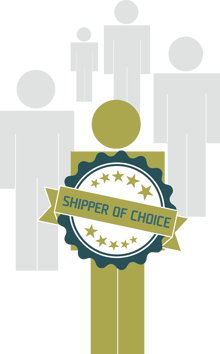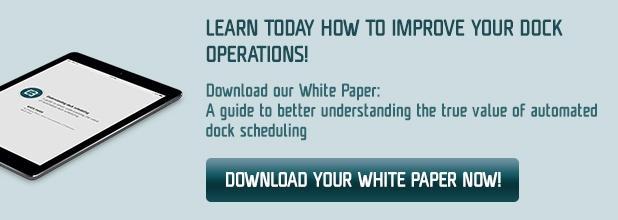Five Topics to Ponder at Year End

This year we’re abandoning our traditional Christmas blog in favor of an end-of-year retrospect on the topics we covered in 2015. Since our mission is to help organizations improve the flow of goods in and out of their facilities through an efficient management of live and drop loads, our focus has been on events and issues that impact dock and yard operations.
Here’s a recap of the most important topics we covered in 2015.
-
Drivers shortage in the transportation industry
-
Why sites should become shippers of choice and how to get there
-
Chain of Responsibility; what is being done in North America, Australia and Europe.
-
How to increase productivity with mobile technology in yard management and dock scheduling
-
The undeniable growth of SaaS in the supply chain, its benefits in a world where software systems are transitioning from systems of records to systems of engagement.
Driver Shortage
The driver shortage issue was broadly covered in the media and, admittedly, while solving the root cause of this problem is out of facility managers’ control, there are things that can be done by each operation that will improve the situation. Reducing unload times by insisting on palletized product and eliminating driver wait times through formal dock schedules are a few examples of solutions that can be implemented. It’s a problem that risks increasing your logistics cost and affecting your service levels. As we explained in our blog ‘Driver Shortage – Running on Empty’, this doesn’t mean a facility must play victim to these demographic and structural changes in the trucking industry. Countering the impact of this change in the transportation industry has been the cornerstone of an international effort to make facilities more efficient; a term now accepted as becoming a Shipper of Choice.
Shipper of Choice
 Unlike the driver shortage issue, becoming a Shipper of Choice is something that is within each facility’s control. Similar to any continuous improvement initiative, these are targeted efforts that facilities can address that provide direct benefits (i.e., reduced driver detention charges, faster turn-around times, reduced carrier rates, etc.) and indirect improvements (i.e., improved customer and supply chain relationships, better flow of goods, reduced stress levels at the docks, etc.). In our first blog on this topic ‘Carrier Review – On the Road to Becoming a Shipper of Choice’, we provided tips on how to establish the process, set objectives, and how to collaborate with your supply chain partners. Furthermore, and respecting the fact that each facility (e.g., distribution versus manufacturing, fresh produce versus consumer goods, collect versus prepaid) has different challenges, we wrote a second blog ‘3 Key Tips to Becoming a Shipper of Choice’ that emphasizes the need to adapt your strategy according to your business profile. For a more extensive reading on how to become a shipper of choice, we invite you to download our white paper: ‘Stay in the Driver’s Seat by Becoming a Shipper of Choice’.
Unlike the driver shortage issue, becoming a Shipper of Choice is something that is within each facility’s control. Similar to any continuous improvement initiative, these are targeted efforts that facilities can address that provide direct benefits (i.e., reduced driver detention charges, faster turn-around times, reduced carrier rates, etc.) and indirect improvements (i.e., improved customer and supply chain relationships, better flow of goods, reduced stress levels at the docks, etc.). In our first blog on this topic ‘Carrier Review – On the Road to Becoming a Shipper of Choice’, we provided tips on how to establish the process, set objectives, and how to collaborate with your supply chain partners. Furthermore, and respecting the fact that each facility (e.g., distribution versus manufacturing, fresh produce versus consumer goods, collect versus prepaid) has different challenges, we wrote a second blog ‘3 Key Tips to Becoming a Shipper of Choice’ that emphasizes the need to adapt your strategy according to your business profile. For a more extensive reading on how to become a shipper of choice, we invite you to download our white paper: ‘Stay in the Driver’s Seat by Becoming a Shipper of Choice’.
Chain of Responsibility
As everyone in the supply chain continues to strive for efficiencies, it is of growing importance to recognize the interdependencies of all the supply chain participants, be they shippers, consignees or carriers. When it comes to driver and road safety, regulatory bodies around the world have taken note of this. Without diminishing drivers’ responsibility relative to safety, governments (i.e., United States, Canada , Australia, Western Europe) have introduced to varying degrees legislation that extend the responsibility to anyone who incites a driver to break the law. This is now referred to the Chain of Responsibility (CoR). Executive officer, employer, prime contractor, operator, freight forwarder, agent/broker, scheduler, shipper, consignee, loading manager, loader and unloader, take note – under the Chain of Responsibility, you are all potentially accountable for driver offences as you all now have a role to play in ensuring compliance with safety regulations. To get more insights on the concept of Chain of Responsibility and how it can affect your business, we invite you to download our white paper: ‘Understanding Chain of Responsibility in the Supply Chain’.
Mobile Technology and the Supply Chain
From the technology front, write-ups in 2015 have continued to regularly talk about mobile technology and its impact in supply chain. C3 has released a comprehensive group of mobile applications – C3 Warehouse (execution screen for our web based dock scheduling system), C3 Shunter (yard driver app) and C3 Dock (dock control screen for our SaaS Yard Management System). Over and above the practicality of simply being mobile, applications can leverage the strengths of the some 10 sensors embedded in smartphones and tablets, including location, temperature, and camera. The adoption of mobile technology is bringing new functionality that was previously unimaginable or at the very least, expensive to deploy and to maintain. Furthermore, this provides companies a window of connectivity to the Internet of Things, potentially unleashing greater collaboration, visibility and efficiencies with your supply chain partners and customers.
SaaS Supply Chain Management Systems
 Although the growing acceptance of Software-as-a-Service (SaaS) is no longer debated, we feel it important to mention it again because 2015 was a milestone year for us in this regard. We are proud to have deployed our new SaaS yard management offering - C3 Yard. It is an entirely new YMS, featuring advanced functionality, a modern user interface that is highly configurable and scalable. After 15 years of experience in the yard management industry it was the logical next step to provide a cloud based YMS. Our SaaS platform is the present and the future. Combining mobile technology and Web Services makes collaboration and integration limitless. Rest assured, this isn’t the last time you’ll hear us talk about this subject.
Although the growing acceptance of Software-as-a-Service (SaaS) is no longer debated, we feel it important to mention it again because 2015 was a milestone year for us in this regard. We are proud to have deployed our new SaaS yard management offering - C3 Yard. It is an entirely new YMS, featuring advanced functionality, a modern user interface that is highly configurable and scalable. After 15 years of experience in the yard management industry it was the logical next step to provide a cloud based YMS. Our SaaS platform is the present and the future. Combining mobile technology and Web Services makes collaboration and integration limitless. Rest assured, this isn’t the last time you’ll hear us talk about this subject.
In the meantime, if you are interested to learn more about how SaaS systems are influencing the modern supply chain, we invite you to read one of our recent blog ‘5 Big Benefits of Cloud-Based Supply Chain Management Systems’.
The end of the year is always a good time to reflect on our accomplishments and take stock of those projects that we weren’t able to realize. Having read our Top 5 for 2015, you could reflect on your operations and ask yourself these five year end questions:
-
Is the driver shortage issue affecting my transportation costs?
-
Am I on the road to becoming a shipper of choice and thereby sustaining the growth of my bottom line?
-
Am I collaborating with drivers to ensure that they respect safety regulations?
-
Am I leveraging mobile technology on my docks, gate, yard in order to reduce equipment costs and improve worker productivity?
-
Is it time to look at agile and collaborative SaaS systems to replace rigid on-premise systems?
On behalf of the entire team at C3 Solutions, we wish to thank our readership and especially our customers for making 2015 an outstanding year. Wishing you all a wonderful holiday season and looking forward to communicating with you again in the New Year.

